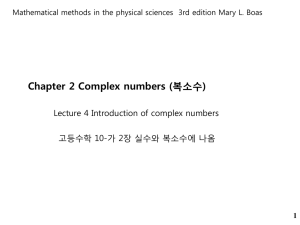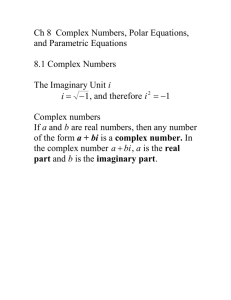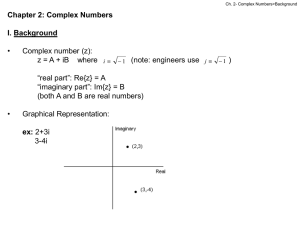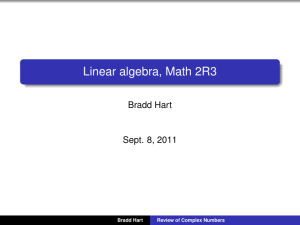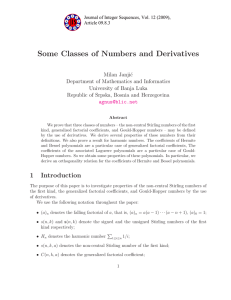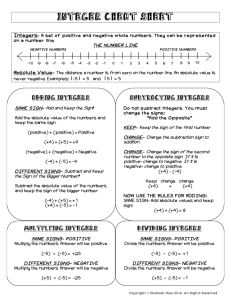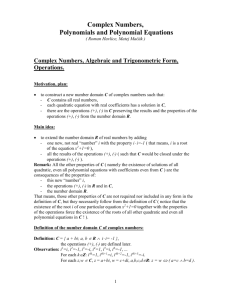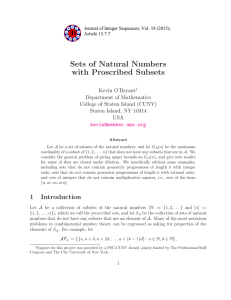Lecture 6-9
advertisement
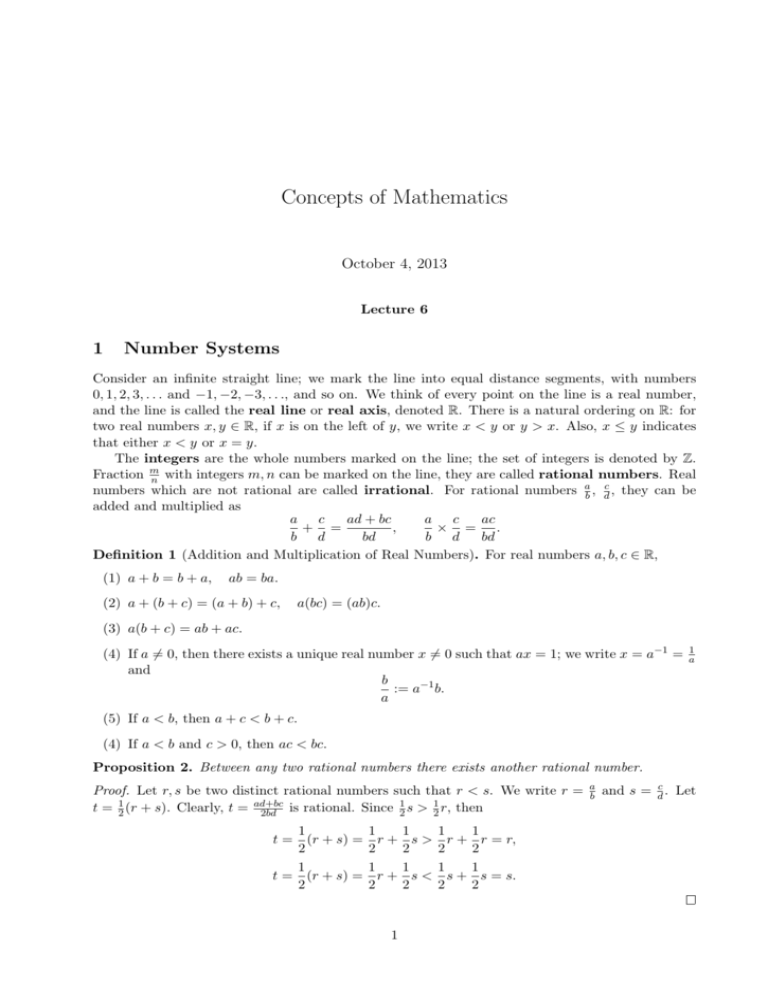
Concepts of Mathematics
October 4, 2013
Lecture 6
1
Number Systems
Consider an infinite straight line; we mark the line into equal distance segments, with numbers
0, 1, 2, 3, . . . and −1, −2, −3, . . ., and so on. We think of every point on the line is a real number,
and the line is called the real line or real axis, denoted R. There is a natural ordering on R: for
two real numbers x, y ∈ R, if x is on the left of y, we write x < y or y > x. Also, x ≤ y indicates
that either x < y or x = y.
The integers are the whole numbers marked on the line; the set of integers is denoted by Z.
Fraction m
n with integers m, n can be marked on the line, they are called rational numbers. Real
numbers which are not rational are called irrational. For rational numbers ab , dc , they can be
added and multiplied as
a c
ad + bc
a c
ac
+ =
,
× = .
b d
bd
b d
bd
Definition 1 (Addition and Multiplication of Real Numbers). For real numbers a, b, c ∈ R,
(1) a + b = b + a,
ab = ba.
(2) a + (b + c) = (a + b) + c,
a(bc) = (ab)c.
(3) a(b + c) = ab + ac.
(4) If a 6= 0, then there exists a unique real number x 6= 0 such that ax = 1; we write x = a−1 =
and
b
:= a−1 b.
a
1
a
(5) If a < b, then a + c < b + c.
(4) If a < b and c > 0, then ac < bc.
Proposition 2. Between any two rational numbers there exists another rational number.
Proof. Let r, s be two distinct rational numbers such that r < s. We write r =
1
1
t = 12 (r + s). Clearly, t = ad+bc
2bd is rational. Since 2 s > 2 r, then
1
t = (r + s) =
2
1
t = (r + s) =
2
1
r+
2
1
r+
2
1
1
s>
2
1
s<
2
1
r+
2
1
s+
2
1
r = r,
2
1
s = s.
2
a
b
and s = dc . Let
√
Proposition 3. 2 is irrational.
√
√
Proof. Suppose 2 is rational, say 2 = m
n , where m and n are integers having no common factors.
m2
2
2
Then 2 = n2 , i.e., m = 2n . Clearly, m2 is even. So m must be even. Write m = 2k. Then
m2 = 4k 2 = 2n2 . It follows that n2 = 2k 2 is even. By the same token, we see that n is even. Hence
m
n is not in reduced form. This is a contradiction.
Proposition 4. Let a be an irrational number and r a rational number. Then
(1) a + r is irrational, and
(2) if r 6= 0, then ar is irrational.
If a and b are distinct nonzero irrational real numbers then ab is irrational. (Wrong! Why?)
Proposition 5. Between any two real numbers there is an irrational number.
√
Proof. Let a and b be two real numbers with a < b. Choose a positive integer n such that n >
√
Case 1: If a is rational, then a +
2
b−a .
2
n
is irrational, and
√
√
2
2
a<a+
<a+ √
= b.
n
2/(b − a)
1
n
is irrational, and
√
√
1
2
2
a<a+ <a+
<a+ √
= b.
n
n
2/(b − a)
Case 2: If a is irrational, then a +
2
Decimals
Lecture 7
Proposition 6. Let x be a real number.
(1) If x 6= 1, then
1 + x + x2 + · · · + xn =
1 − xn+1
.
1−x
(2) If |x| < 1, then
1 + x + x2 + x3 + · · · =
1
.
1−x
The decimal expression a0 .a1 a2 a3 · · · (in base 10), where a0 is an integer, and a1 , a2 , . . . are
numbers from 0 to 9, is the real number
a0 +
a1
a2
+ 2 + ··· .
10 10
Proposition 7. Every real number x has a decimal expression
x = a0 .a1 a2 a3 · · · .
2
Proof. The real number x must lie between two consecutive integers, say, a0 and a0 + 1, so that
a0 ≤ x < a0 + 1.
Now we divide the interval [a0 , a0 + 1] into 10 equal small intervals. Clearly, x lies in one of these
small intervals. So we can find an integer a1 between 0 and 9 inclusive so that
a0 +
a1 + 1
a1
≤ x < a0 +
.
10
10
Similarly, we divide the interval [a0 + a101 , a0 + a110+1 ] into 10 equal smaller intervals; then x lies in
one of these smaller intervals; and we can find an integer a2 between 0 and 9 inclusive so that
a0 +
a2
a1
a2 + 1
a1
+
≤ x < a0 +
+
.
10 102
10
102
Continuing this procedure, we obtain a sequence
a0 +
a1
a2
an
+ 2 + ··· + n,
10 10
10
which gets as close as we like to x when n is large enough. This is what we mean the decimal
expression a0 .a1 a2 a3 · · · of x.
√
Example 1. Show that 3 ≈ 1.732.
√
Proof. Let x = 3. Since x2 = 3, then 12 = 1 < x2 < 4 = 22 , so 1 < x < 2, thus a0 = 1.
Next, (1.7)2 = 2.89 < x2 < 3.24 = (1.8)2 , then 1.7 < x < 1.8, we have a1 = 7. Similarly,
(1.73)2 = 2.9929 < x2 < 3.0276 = (1.74)2 , then 1.73 < x < 1.74, we have a2 = 3. Since
(1.731)2 = 2.996361 < x2 < 3.003288 = (1.732)2 , then 1.731 < x < 1.732, and a3 = 1. Note
that (1.7319)2 = 2.99947761 < x2 < 3.003288 = (1.732)2 . We have 1.7319 < x < 1.732. Hence
x ≈ 1.732.
Question 1. Can the same real number have two different decimal expressions? If Yes, which
decimal expressions represent the same real number?
0.999 · · · =
=
=
9
9
9
+ 2 + 3 + ···
10 µ 10
10
¶
9
1
1
1+
+
+ ···
10
10 102
9
1
·
= 1.
10 1 − 1/10
Thus
1 = 1.000 · · · = 0.999 · · · .
Similarly,
369
= 0.368999 · · · = 0.369000 · · · .
1000
Proposition 8. If a real number x is expressed (in base 10) in two different expressions:
a0 .a1 a2 a3 · · ·
and b0 .b1 b2 b3 · · · ,
then one of these expressions ends in 999 · · · and the other ends in 000 · · · .
3
Proof. Let k be the left most position where ak 6= bk , k ∈ Z≥0 . Then a0 = b0 , a1 = b1 , . . .,
ak−1 = bk−1 . Without loss of generality, we may assume ak > bk . Thus ak ≥ bk + 1. Since
x = a0 .a1 a2 · · · = b0 .b1 b2 · · · , we have
a0 .a1 a2 · · · ak 00 · · · ≤ a0 .a1 a2 · · · = x = b0 .b1 b2 · · · ≤ b0 .b1 b2 · · · bk 999 · · · .
That is,
ak−1
bk−1
a1
ak
b1
bk
+ · · · + k−1 + k ≤ x ≤ b0 +
+ · · · + k−1 + k + 9
a0 +
10
10
10
10
10
10
It follows that
µ
ak ≤ bk + 9
1
1
+
+ ···
101 102
µ
1
1
+
+ ···
10k+1 10k+2
¶
.
¶
= bk + 1 ≤ ak .
Hence ak = bk + 1, and
x = a0 .a1 a2 . . . ak 000 · · · = b0 .b1 b2 . . . bk 999 · · · .
We then have that a0 .a1 a2 · · · ends with 000 · · · and b0 .b1 b2 · · · ends with 999 · · · .
For rational numbers
18
7 ,
and 821, we have
18
= 2.571428571428571428 · · · = 2.571428,
7
8
= 0.380952380952380952 · · · = 0.380952.
21
Proposition 9. A real number x is rational if and only if its decimal expression is periodic.
Proof. Let x = m
n be a rational number in reduced form, where n is a positive integer. Do the
following division to have quotients and remainders:
m = q0 n + r0 , 0 ≤ r0 < n,
10r0 = q1 n + r1 , 0 ≤ r1 < n,
10r1 = q2 n + r2 , 0 ≤ r2 < n,
··· ··· ········· ·········
steps ≤ n − 1
10rk−1 = qk n + rk ,
0 ≤ rk < n,
10rk = qk+1 n + rk+1 , 0 ≤ rk+1 < n,
l
······ ··· ············
············
10rk+l−1 = qk+l n + rk+l ,
rk+l = rk ,
10rk+l = qk+l+1 n + rk+l+1 , rk+1+1 = rk+1 ,
l
······ ··· ···············
············
..
.
Since the remainders dividing by n can be only 0, 1, 2, . . . , n − 1, the remainders must repeat
periodically. Thus qk+l+1 = qk+1 , qk+l+2 = qk+2 , . . .; that is, qa+il = qa for a ≥ k + 1.
m
n
= q0 .q1 q2 · · · qk qk+1 qk+2 · · · qk+l qk+l+1 qk+l+2 · · · qk+2l · · ·
{z
}|
{z
}
|
l
l
= q0 .q1 q2 · · · qk qk+1 qk+2 · · · qk+l qk+1 qk+2 · · · qk+l · · ·
{z
}|
{z
}
|
l
l
= q0 .q1 q2 · · · qk qk+1 qk+2 · · · qk+l .
4
It is clear that 1 ≤ l ≤ n. Moreover, if n ≥ 2, then l ≤ n − 1. In fact, if one of the remainders ri is
zero then all the following remainders are zero; so l = 1. Otherwise, all remainder ri are nonzero.
Of course, l ≤ n − 1.
Conversely, given a number x = a0 .a1 a2 . . . ak q1 q2 . . . ql having periodic decimal expression.
Then
ak
a1
+ · · · + k + r,
x = a0 +
10
10
where
1 ³ q1
ql ´
1 ³ q1
ql ´
1 ³ q1
ql ´
r =
+
·
·
·
+
+
+
·
·
·
+
+
+
·
·
·
+
+ ···
l
10k 10
10l µ 10k+l 10
10
10k+2l 10
10l
¶
1 ³ q1
ql ´
1
1
=
+
·
·
·
+
1 + l + 2l + · · ·
k
l
10 10
10
10
10
³
´
l
ql
1
q1
10
+ ··· + l
.
=
k
10 10
10 10l − 1
Example 2.
µ
¶
6
1
8
1
8
1
8
1.618 = 1 +
+
1+
+
+
+
+
+ ···
10 102
10 102 103 104 105
6
1 102
8 102
= 1+
+ 2·
+ 3·
10 10
99
10
99
6
1
8
1602
89
= 1+
+
+
=
= .
10 99 990
990
55
Lecture 9
3
Inequalities
An inequality is a statement about real numbers involving one of the symbols >, ≥, <, or ≤. We
start with the following rules about inequalities. The following rules of real numbers are motivated
by the properties of the real axis – the set of real numbers.
Definition 10. Rules of Inequalities
1. For each x ∈ R, then either x < 0 or x = 0 or x > 0, and just one of these three is true.
2. If x < y, y < z, then x < z.
3. If x < y and c ∈ R, then x + c < y + c.
4. If x > 0, y > 0, then xy > 0.
5. If x < y, then −x > −y.
For two real numbers x, y, we use x ≤ y to denote either x < y or x = y. Analogously, x ≥ y
denotes either x > y or x = y.
Example 3.
1. If x < 0, then −x > 0. If x ≥ 0, then −x ≤ 0.
2. If x 6= 0, then x < 0 or x > 0, and x2 > 0.
5
3. If x < y and u > 0, then ux < uy.
Proof. Since x < y, then x − x < y − x, that is, 0 < y − x. Thus u · 0 < u(y − x), that is,
0 < uy − ux. Hence, 0 + ux < uy − ux + ux, that is, ux < uy.
4. If x > 0, then
1
x
> 0.
−1
Proof. Suppose x1 < 0. Then −1
x > 0. Thus x · x > 0, that is, −1 > 0, this is a contradiction.
So x1 ≥ 0. Since x1 6= 0, we conclude that x1 > 0.
Example 4. Let x1 , x2 , . . . , xn ∈ R be nonzero. Assume k of them are negative and the rest are
positive. Then
½
> 0 if k is even,
x1 x2 · · · xn =
< 0 if k is odd.
Proof. Without loss of generality we may assume that x1 , . . . , xk are negative and xk+1 , . . . , xn are
positive. Then −x1 , . . . , −xk , xk+1 , . . . , xn are all positive. Thus
(−1)k x1 x2 · · · xn = (−x1 ) · · · (−xk )xk+1 · · · xn > 0.
If k is even, the above inequality means that x1 x2 · · · xn > 0. If k is odd, −x1 x2 · · · xn > 0; thus
x1 x2 · · · xn < 0.
3
Example 5. For which values of x is x < x+2
?
Answer. We cannot multiply x + 2 to both side as x + 2 may not be all positive or all negative.
instead, we do
x−
3
−x<0
x+2
x(x + 2) − 3
(x + 3)(x − 1)
=
< 0.
x+2
x+2
⇐⇒
1
to be negative, we have two situations: (i)
To have the product of the three terms x + 3, x − 1, x+2
one of the three is negative and the other two are positive; (ii) all three are negative. In the former
case, we have
(1) x + 3 < 0, x − 1 > 0, and x + 2 > 0, that is, x < −3, x > −1, x > −2. No such value x.
(2) x + 3 > 0, x − 1 < 0, x + 2 > 0, that is, x > −3, x < 1, x > −2. Then −2 < x < 1.
(3) x + 3 > 0, x − 1 > 0, x + 2 < 0, that is, x > −3, x > 1, x < −2. No such value x.
In the latter case,
x + 3 < 0, x − 1 < 0, x + 2 < 0
⇐⇒
x < −3, x < 1, x < −2
⇐⇒
x < −3.
So our answer is x < −3 or −2 < x < 1, that is x ∈ (−∞, 3) ∪ (−2, 1).
Example 6. Show that for all real numbers x we have x2 + 3x + 3 > 0.
¡
¢2
¡
¢2
¡
¢2
Proof. Note that x2 + 3x + 3 = x + 32 + 34 . Since x + 32 ≥ 0 and 34 > 0, then x + 23 +
3
2
4 > 0. So x + 3x + 3 > 0.
The modulus of a real number x is
|x| =
½
3
4
≥
x if x ≥ 0,
−x if x < 0.
Example 7. For a positive real number r, |x| < r means −r < x < r; |x| ≤ r means −r ≤ x ≤ r.
For a, r ∈ R with r > 0, we have
|x − a| < r ⇔ a − r < x < a + r;
|x − a| ≤ r ⇔ a − r ≤ x ≤ a + r.
6
4
Rational Powers
Theorem 11 (Definition). Let n be a positive integer. For each positive real number b, there exists
a unique positive real number x such that xn = b. We write the number x in terms of b as
1
x = bn .
Let b be a positive real number b > 0. For rational numbers m
n ∈ Q with n > 0 and m ∈ Z,
we define the rational power (also known as fractional power) of b to m
n as the positive real
number
m
1
b n := (b n )m .
m
m
We need to show that b n is well-defined when m
n is not in reduced form. Let n be in reduced form
1
n
and consider mk
nk with k ∈ Z+ . For the positive integer b , there exists a unique positive integer a
1 1
1
1
k
such that a = b n , that is, a = (b n ) k . Let us write y = b nk , that is, y nk = b. Thus
£ 1 1 ¤nk £¡ 1 1 ¢k ¤n
1
ank = (b n ) k
= (b n ) k
= (b n )n = b.
This means that y = a. Therefore
¡ 1 ¢m
mk
1
m
b nk = (b nk )mk = y mk = amk = (ak )m = b n
= bn.
13
1
For instance, 7− 5 = (7 5 )−13 =
√1
.
( 5 7)13
Proposition 12 (Power Rules). Let x, y ∈ R+ and p, q ∈ Q. Then
(a) xp xq = xp+q .
(b) (xp )q = xpq .
(c) (xy)p = xp y p .
Proof. (a) We first assume that p, q ∈ Z. It is trivial when p = 0 or q = 0. If p, q > 0, then
xp xq = |x ·{z
· · x} x
· · x} = x
· · x} = xp+q .
| ·{z
| ·{z
p
If p > 0, q < 0, then
q
p+q
±
· · x} = xp−(−q) = xp+q .
xp xq = x
·
·
·
x
| {z } |x ·{z
p
−q
It is similar when p < 0, q > 0 and when p, q < 0. Now Let p =
m
n,
q = hk . Then
¡ 1
¡ 1 ¢nh ¡ 1 ¢mk+nh
mk+nh
m
h
mk
nh
xp xq = x n x k = x nk x nk = x nk )mk x nk
= x nk
= x nk = xp+q .
(b) We first establish the rule for p, q ∈ Z. It is obviously true when p = 0 or q = 0. If
1
p > 0, q > 0, it is trivial. If p > 0, q < 0, then (xp )q = (xp1)−q = x−pq
= xpq . If p < 0, q > 0, then
¢
¡
1
1 −q
1 q
= x−pq
= xpq . If p, q < 0, then (xP )q = 1/( x−p
) = 1/ (x−p1 )−q = 1/ x1pq = xpq .
(xp )q = x−p
7
h
Let p = m
n , q = k with m, n, h, k ∈ Z. It follows from Theorem 11 that there exists a positive
1
real number a such that x = ank , that is, a = x nk , and there exists a positive real number b such
1
1
1
1
that ak = b n . Then ank = (ak )n = b. So b = x, that is, ak = x n . Thus (x nk )k = x n . Therefore
£¡ 1
¢ 1 ¤h £¡
¢ 1 ¤h
m h
mk 1
1
(xp )q = (x n ) k = [(x nk ) k ]h = (x nk )mk k = ((x nk )m )k k
£¡ 1 ¢m ¤h ¡ 1 ¢mh
mh
= x nk
= x nk = xpq .
=
x nk
(c) It is trivial to establish the rule for p ∈ Z. Let p = m
n . Then
1
£ 1
¤
£¡
¢
¤m
1
1
1
1
1
1
1
m
= (x n )n (y n )n n = (xy)p .
xp y p = (x n )m (y n )m = (x n y n )m = (x n y n )n n
5
Complex Numbers
A complex number z is a combination of real numbers written in the form
z = a + bi,
where the addition and multiplication are the same as the operations of algebraic terms, with an
additional rule i2 = −1; a is called the real part of z, and b the imaginary part, and we write
a = Re(z),
b = Im(z).
We denote by C the set of all complex numbers.
For any real number a, it is automatically a complex number with Im(a) = 0; we write a instead
of a + 0i without mentioning the zero imaginary part. The real number 0 is still the zero in complex
numbers as 0 + z = z for any complex number z; the real number 1 is still the unit for complex
number as 1z = z for any complex number z. For each complex
number z = a + bi, the complex
√
2
number z̄ = a − bi is called the conjugate of z, and |z| = a + b2 is called the modulus of z;
|z|2 = z z̄ = z̄z = a2 + b2 .
The minus of z is defined as a complex number w such that z + w = 0, and it is denoted by
−z. If z = a + bi, then −z = −a − bi. The subtract of a complex number w from a complex
number z is defined as
z − w = z + (−w).
Similarly, the inverse of a complex number z(6= 0) is defined as a complex number w such that
zw = 1; the inverse of z is denoted by z1 or z −1 . Since 0w = 0 for any w ∈ C, there is no (complex)
inverse for 0. If z = a + bi 6= 0, then zz −1 = 1; multiplying both sides by z̄ = a − bi, we have
z̄zz −1 = z̄,
i.e. |z|2 z̄ = (a2 + b2 )z −1 = z̄.
Hence
z̄
a
b
= 2
−
i.
|z|2
a + b2 a2 + b2
Thus for complex numbers w and z with z 6= 0, the division wz is defined as
w
= wz −1 .
z
If z = a + bi and w = c + di, then
z −1 =
(c + di)(a − bi)
ac + bd ad − bc
w
wz̄
= 2
+ 2
i.
= 2 =
z
|z|
a2 + b2
a + b2
a + b2
8
6
De Moivre’s Rule
√
For complex number z = a + bi, let r = a2 + b2 = |z|. Then a = r cos θ and b = r sin θ, and z can
be written as
z = r(cos θ + i sin θ).
Theorem 13. Let z1 = r1 (cos θ1 + i sin θ1 ), z2 = r1 (cos θ2 + i sin θ2 ). Then
z1 z2 = r1 r2 [cos(θ1 + θ2 ) + i sin(θ1 + θ2 )].
Proof. Recall the trigonometric formulas:
cos(θ1 + θ2 ) = cos θ1 cos θ2 − sin θ1 sin θ2 ,
sin(θ1 + θ2 ) = cos θ1 sin θ2 + sin θ1 cos θ2 .
Then
z1 z2 = r1 r2 [cos θ1 + i sin θ1 )(cos θ2 + i sin θ2 ]
= r1 r2 [(cos θ1 cos θ2 − sin θ1 sin θ2 ) + i(cos θ1 sin θ2 + sin θ1 cos θ2 )]
= r1 r2 [cos(θ1 + θ2 ) + i sin(θ1 + θ2 )].
Lecture 10
Corollary 14. Let z = r(cos θ + i sin θ). Then for any integer n,
z n = rn (cos nθ + i sin nθ).
Proof. For positive integer n it is easy to apply the De Moivre’s rule. Note that
z −1 =
z̄
1
= (cos θ − i sin θ) = r−1 [cos(−θ) + i sin(−θ)] = r1 (cos θ1 + i sin θ1 ),
z z̄
r
where r1 = r−1 and θ1 = −θ. Then for positive integer n,
³
´
z −n = r1n (cos nθ1 + i sin nθ1 ) = r−n cos(−nθ) + i sin(−nθ) .
Definition 15. For any angle θ the complex number cos θ + i sin θ is denoted by eiθ , i.e.,
eiθ = cos θ + i sin θ.
Recall the trigonometric functions cos θ and sin θ are defined by
cos θ =
x
,
r
sin θ =
y
.
r
where x2 + y 2 = r2 .
Theorem 16.
eiθ1 eiθ2 = ei(θ1 +θ2 ) .
Example 8. Computer (−1 +
√
3i)20 .
9
α20
√
¡
¢
2π
3i. Then α = 2 cos 2π
+
i
sin
3
3 . Thus
µ
¶
µ
¶
√
40π
40π
4π
4π
= 220 cos
+ i sin
= 220 cos
+ i sin
= 219 (−1 − 3i).
3
3
3
3
Let α = −1 +
Example 9. Deriving trigonometric formulas. Consider (cos θ + i sin θ)3 = cos 3θ + i sin 3θ. Let
a = cos θ, b = sin θ. Then
(a + bi)3 = (a2 − b2 + 2abi)(a + bi)
= (a2 − b2 )a − 2ab2 + (2a2 b + a2 b − b3 )i
= a3 − 3ab2 + (3a2 b − b3 )i.
Thus
cos 3θ = cos3 θ − 3 cos θ sin2 θ = 4 cos3 θ − 3 cos θ.
Similarly,
sin 3θ = 3 cos2 θ sin θ − sin3 θ = 3 sin θ − 4 sin3 θ.
Proposition 17. (a) If z = reiθ , then z̄ = re−iθ .
(b) Let z1 = r1 eiθ1 and z2 = r2 eiθ2 . Then z1 = z2 if, and only if, r1 = r2 and θ1 = θ2 + 2kπ for
some k ∈ Z.
Proof. (a) is obvious. (b) If z1 = z2 , then r1 = r2 , and 1 = z1 /z2 = ei(θ1 −θ2 ) . Hence θ1 − θ2 = 2kπ
for some k ∈ Z. The other part is obvious.
7
Roots of unity
2πi
Definition 18. For any positive integer n, let w = e n ; the nth roots of unity are the complex
numbers
1, w, w2 , . . . , wn−1 .
They are evenly distributed on the unit circle.
Example 10. For n = 2, they are 1, −1. For n = 4, they are 1, i, −1, −i. For n = 3, they are
1,
e
2πi
3
Theorem 19. For the nth root of unity w = e
,
2πi
n
e
4πi
3
.
with n ≥ 2,
1 + w + w2 + · · · + wn−1 = 0.
Proof. Since wn = 1 and 1 − w 6= 0, then
(1 − w)(1 + w + · · · + wn−1 ) = 1 − wn = 0.
Hence 1 + w + · · · + wn−1 must be zero.
When a complex number z = a + bi is interpreted as an vector or force from the origin (0, 0)
to the position (a, b), the physical meaning of the above identity means that the sum effect of the
forces 1, w, w2 , . . . , wn−1 cancels each other at the origin.
Lecture 11
10
8
Cubic Equations (optional)
The general cubic equation may be written as
x3 + ax2 + bx + c = 0.
(1)
Let x = x − a3 . Then x3 = (y − a/3)3 = y 3 − ay 2 + (a2 /3)y − a3 /27, y 2 = x2 − (2a/3)y + a2 /9.
Substitute x = y − a/3 into (1); the equation becomes the form
y 3 + 3hy + k = 0.
(2)
Let y = u + v. Then
y 3 = u3 + v 3 + 3u2 v + 3uv 2 = u3 + v 3 + 3uv(u + v) = u3 + v 3 + 3uvy.
This means that the equation of the form y 3 − 3uvy − (u3 + v 3 ) = 0 readily has a solution y = u + v.
So we set
h = −uv, k = −(u3 + v 3 ).
Since v = −h/u, then v 3 = −h3 /u3 . Thus k = −(u3 − h3 /u3 ) becomes
u6 + ku3 − h3 = 0,
which is a quadratic equation in u3 . Then u3 as
3
u =
−k +
Thus
3
√
k 2 + 4h3
.
2
−k −
3
v = −k − u =
√
k 2 + 4h3
.
2
Therefore we obtain a solution
s
y =u+v =
−k +
3
√
s
k2
+
4h3
2
√
2
+
3
−k −
√
k 2 + 4h3
.
2
√
3
2
3
There are three cubic roots for u3 = −k+ 2k +4h and also three cubic roots for v 3 = −k− 2k +4h .
So theoretically there are nine possible values to be the solutions; but there are only three solutions,
some of them are the same.
√
2
3
Let u be a cubic root of −k+ 2k +4h , and let ω = e2πi/3 . Then the other two cubic roots are
uω, uω 2 . Therefore the solutions for (2) are given by
u−
h
,
u
uω −
hω 2
,
u
uω 2 −
Example 11. Consider the equation
x3 − 3x + 2 = 0.
Since h = −1, k = 2, we have
3
u =
−k +
√
k 2 + 4h3
= −1.
2
11
hω
.
u
So we have u = −1, thus the three solutions are given by
u−
h
= −2,
u
hω 2
= −ω − ω 2 = 1 − (1 + ω + ω 2 ) = 1,
u
hω
= −ω 2 − ω = 1.
uω 2 −
u
We may also solve the problem directly by the factorization (x − 1)(x − 1)(x + 2) = 0.
uω −
Example 12. Consider the equation
x3 − 6x − 6 = 0.
We have h = −2 and k = −6. Thus
3
u =
So u =
√
3
4. Thus
x1 = u −
−k +
√
k 2 + 4h3
= 4.
2
h
= 41/3 + 2/41/3 = 22/3 + 21/3 ,
u
hω 2
= (21/3 + 22/3 )ω + (2−1/3 + 2−2/3 )−1 ω 2 ,
u
hω
x3 = uω 2 −
= (2−1/3 + 2−2/3 )−1 ω + (21/3 + 22/3 )ω 2 .
u
x2 = uω −
9
Fundamental Theorem of Algebra
Theorem 20. Every polynomial equation of degree at leat 1 has a root in C.
Theorem 21. Every polynomial of degree n factories as a product of linear polynomials, and has
exactly n roots (counted with multiplicity) in C.
Proposition 22. Let α1 , . . . , αn be the roots of the equation
xn + an−1 xn−1 + · · · + a1 x + a0 = 0.
Then
s1 = α1 + α2 + · · · + αn = −an−1
X
s2 =
αi αj = an−2 ,
i<j
s3 =
X
αi αj αk = −an−3 ,
i<j<k
sk =
X
··· ,
αi1 αi2 · · · αik = (−1)k an−k ,
i1 <i2 <···<ik
··· ,
sn = α1 α2 · · · αn = (−1)n a0 .
12
Example 13. Find a cubic equation with roots 2 + i, 2 − i, and 3.
s1 = α1 + α2 + α3 = 7,
s2 = α1 α2 + α1 α3 + α2 α3 = 17,
s3 = α1 α2 α3 = 15.
(x − 3)(x2 − 4x + 5) = x3 − 7x2 + 17x − 15 = 0.
Example 14. Let α and β be roots of equation x2 − 5x + 9 = 0. Find a quadratic equation with
roots α2 and β 2 .
The quadratic equation is of the form
x2 − (α2 + β 2 )x + α2 β 2 = 0.
Since α + β = 5 and αβ = 9, we have 52 = (α + β)2 = α2 + β 2 + 2αβ = α2 + β 2 + 18. Then
α2 + β 2 = 7, α2 β 2 = 81. Thus
x2 − 7x + 81 = 0.
13


![5.5 The Haar basis is Unconditional in L [0, 1], 1 < 1](http://s2.studylib.net/store/data/010396305_1-450d5558097f626a0645448301e2bb4e-300x300.png)
